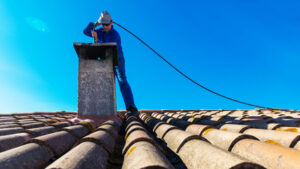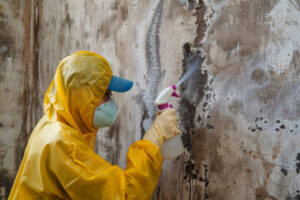Chimney cleaning may not be the most glamorous of home maintenance, but it’s essential to a safe and comfortable home. Regular cleaning and inspections can help prevent costly repairs and masonry damage.

Creosote buildup is a serious fire hazard and can corrode chimney liners, dampers, and masonry. It can also obstruct smoke and carbon monoxide venting, leading to health risks. Contact Chimney Care Charleston for professional help.
Creosote is a black or brown byproduct of wood burning. It is a flammable substance that is very dangerous to breathe and can cause chimney fires. It can also clog chimneys and restrict the flow of smoke. Keeping up with regular creosote removal is essential to keep your fireplace and chimney functioning properly.
Creosote can form when unseasoned or damp wood is burned in the fireplace. It can also build up if the fireplace is used often and if the chimney is not cleaned regularly. The most common signs of creosote build-up are soot staining around the fireplace, poor chimney draft, and black smoke coming from the fireplace.
Chimney sweeps use specialized tools to remove creosote. These include long rods with bristles at the end and protective gear to avoid falling ash and soot. They typically start at the top of the chimney and work their way down. They may also spray a chemical product into the flue which breaks down the creosote and makes it easier to remove with a brush. If the creosote has reached stage 2 or 3, which is hard and resembles tar, a professional will need to come in and remove it.
In addition to removing creosote, professionals will also check the chimney for any damage or blockages. A clean chimney will allow the proper flow of smoke and prevent a chimney fire. It will also make it much easier for an inspection to be performed, which is something every homeowner should have done at least once a year.
Inspections
Having your chimney professionally inspected helps to ensure it’s working properly and is safe to use. A professional sweep will check for blockages, cracks, and other issues that may need attention. They’ll also look at the flue liner to identify any cracks or damage that could cause toxic carbon monoxide to enter your home.
Creosote buildup is highly flammable and the leading cause of chimney fires, and an annual inspection can help prevent it. A routine chimney sweeping will remove this dangerous material from the chimney, reducing your risk of chimney fires and keeping you and your family safer. Chimney inspections can also detect problems with the chimney masonry, such as cracked bricks and crumbling mortar. This can lead to water leaks in your fireplace and chimney, causing further damage to the structure of your house.
Chimneys can change shape over time due to settling and moisture, which can affect the flue’s ability to vent smoke correctly. A routine chimney sweeping will help to identify these changes and recommend any necessary repairs to keep your family safe from chimney fires.
A level two inspection is a more thorough examination, often required when there are changes to the type of fuel used in the fireplace or its venting system. A level two inspection also includes checking areas of your attic, crawl space, and basement that are accessible near the fireplace, and can include a video inspection.
A level three chimney inspection is the most extensive, and involves partial demolition to allow full access to the chimney and its components. It’s usually recommended after a chimney incident, dramatic weather event (like an earthquake or hurricane), before selling a property, and when a chimney is showing signs of structural damage.
Relining
A chimney liner is one of the most vital components of your fireplace. This inner chimney lining protects the combustible parts of your home from a fire and helps smoke, creosote and other gases to escape the fireplace. It also prevents dangerous carbon monoxide from entering your house through the flue. However, your chimney liners can wear out over time and may become damaged or cracked. In such cases, it is best to hire a professional chimney relining service for your safety and protection.
The process involves inserting a new lining into your chimney structure and then securing it in place using mortar. A new chimney flue lining can be made of either flexible or rigid materials. The choice of the material largely depends on the type of fuel you burn and your chimney’s size. Rigid liners are often used for wood-burning fireplaces and prefabricated stoves and inserts while flexible liners are typically employed for gas burning appliances.
Relining is an economical way to repair chimney problems without having to rebuild the entire chimney structure. However, it’s important to hire a professional to carry out the work since it is a labor intensive process that requires a lot of skill and experience.
Chimney relining can also improve the exterior appearance of your chimney by removing ugly smoke stains and spalling. This is especially helpful if you have an older chimney with deteriorating brick and mortar.
A professional chimney relining service can also install a chimney cap to prevent ash from falling inside your home, which can cause damage and odors. Lastly, they can install a chimney chase cover to keep combustibles from falling on the fireplace walls and flue.
Smoke Stain Removal
While a fireplace is a beautiful focal point in your home, it can also become an ugly eyesore if smoke staining occurs. If you are tired of looking at your unsightly chimney, a professional cleaning service can help. Chimney sweeps can remove the smoke stains from the masonry without using harsh or toxic chemicals.
In addition to preventing carbon monoxide poisoning, the regular removal of creosote, twigs, leaves, and other debris prevents them from blocking the chimney flue and hindering an adequate amount of air from reaching the fire. This improves the overall efficiency of your fireplace and stove and helps to reduce heating costs.
During the cleaning process, chimney sweeps use rotary brushes to scrub away the accumulated creosote and soot, and high-efficiency vacuums to contain and remove loosened particles. They also inspect the flue for blockages and deterioration, ensuring that the fireplace is safe to use.
A combined sweep and inspection is the most effective way to address your fireplace maintenance needs. Clogged chimneys cause deadly house fires and carbon monoxide poisoning in thousands of households each year, and routine maintenance can prevent them.
When the inner clay liner of your chimney is cracked and damaged, it’s time for a chimney relining. This simple procedure is much less expensive than a chimney rebuild and allows your fireplace to continue functioning safely. Chimney relinings are available in different materials to suit your preferences and the condition of your chimney. Many homeowners choose a stainless steel chimney liner, which is durable and long-lasting.
Spalling
The mortar that holds the bricks together on your chimney has a very limited lifespan. When the mortar starts to deteriorate, it creates an opening for water to enter. When the moisture infiltrates, it can cause damage that goes beyond cosmetic. Over time, this can lead to spalling of the chimney. Spalling is a dangerous problem that can threaten your home’s safety and security. If you notice flakes and clumps of brick on the ground near your chimney, it’s time to call in a professional for a masonry repair.
The most common cause of spalling is water infiltration. Chimneys are exposed to rain, snow, and humid air that can seep into the porous masonry. The absorbed water freezes and expands as it changes to ice, cracking and weakening the bricks and mortar. This process is accelerated in cold climates by repeated freeze-thaw cycles.
Chimneys that are older and haven’t been waterproofed or maintained are more susceptible to moisture damage. A missing chimney cap can also hasten the process by allowing water to seep in through the top of the chimney.
While bricks themselves can last for 100 years or more, the mortar that holds them together has a much shorter lifespan. If you ignore masonry problems, it may only be a matter of time before the chimney is damaged beyond repair.
The good news is that there are several ways to prevent moisture damage, including having a professional install a chimney cap and chimney crown, having the chimney repointed regularly, and using a waterproof sealant every couple of years. Our masonry professionals use a breathable waterproofing chemical that allows the chimney to breathe but keeps water out. By taking these precautions, you can protect your masonry from spalling and other costly damage that can compromise the structural integrity of your chimney.



